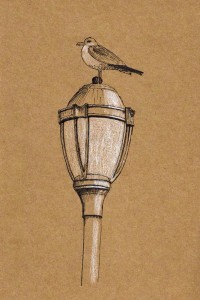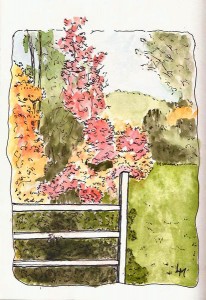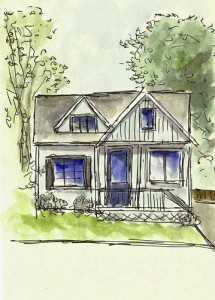Here in North America our society is becoming more and more coarse. The rhetoric of our politicians has become downright rude, we all walk around with headphones one, barely acknowledging one and other and, frankly, too many of us are too afraid of too many things. So it’s hard to continue to believe an axiom that makes life bearable – that people are good.
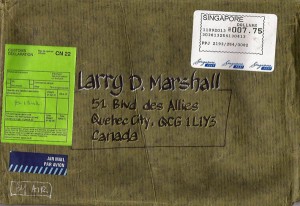 But then something happens and things snap back into perspective. That happened to me when I went to my mailbox and pulled this from the box.
But then something happens and things snap back into perspective. That happened to me when I went to my mailbox and pulled this from the box.
It was addressed to me with a flair that one rarely sees. It came from Singapore. Singapore??? Who did I know in Singapore? I immediately thought of the Urban Sketchers of Singapore but I’ve never met any of them. Who could be sending me something?
And so I opened it in the hopes of gaining some insights. Indeed, the contents were sketcher-oriented. There was a nice toned-paper sketchbook, a leatherette cover for that sketchbook, two Uniball Signo UM-120 pens, and a couple refills for those pens. WOW! The motherlode. Being old I don’t think as quickly as I once did and I was still baffled about who might have sent these items. And then I found the little card, from Patrick Ng.
Patrick is a great guy, who went out of his way to obtain a couple Hero pens for me that I couldn’t have purchased without his help. And we ‘chat’ on Facebook, where we are ‘friends.’ He had been shopping for materials and remembered me, remembered discussions we’d had about the toned-paper sketchbooks made by a friend of his, and he bought me one, and a cover for it so I could fill the sketchbook, get another one and replace it, reusing the cover. He’d sent a couple of the pens he uses regularly because he knew that Uniball don’t import them to the US. People are still good, and Patrick is one of the best.
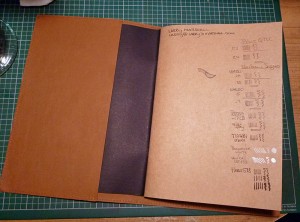 The first thing I did was to test bunch of pens on the paper, which must be 200lb tan-color paper. It’s not heavily sized but it does take watercolors quick nicely. You notice the lack of sizing when you try to do larger washes. But being able to use the paper as a mid-tone and working on both sides towards dark (pen) and lights (colored pencil) is lots of fun.
The first thing I did was to test bunch of pens on the paper, which must be 200lb tan-color paper. It’s not heavily sized but it does take watercolors quick nicely. You notice the lack of sizing when you try to do larger washes. But being able to use the paper as a mid-tone and working on both sides towards dark (pen) and lights (colored pencil) is lots of fun.
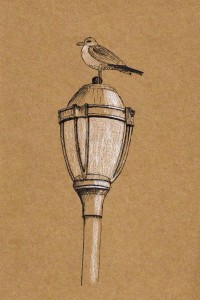 The first full sketch I did was this one, done in Parc Brebeuf, a park not far from my house. The ring-billed gulls like to sit on lamp posts and this one sat around while I drew him…or her.
The first full sketch I did was this one, done in Parc Brebeuf, a park not far from my house. The ring-billed gulls like to sit on lamp posts and this one sat around while I drew him…or her.
I decided that since Patrick had been so nice to send me a sketchbook, the least I could do was walk a mile in his shoes, in a sketching sense. He does a lot of sketches inside restaurants and coffee shops. Sometimes he does them on toned-brown paper, sometimes not. They are always wonderful sketches.
So, I took one of my Hero 578 ‘asian calligraphy’ pens (tip is bent upward), my new sketchbook, and headed to a mall. It was morning and not very busy, which suited me fine.
I actually sketched this while standing up, just outside the restaurant, resting the sketchbook on the wall in the foreground of the sketch. Me, standing, looking in at the restraurant was likely to be disconcerting so after I’d done a bit of the sketch I walked to the three women featured in it and showed them what I was doing.
Normally I would not do such a thing as typically this causes people to start posing. But in this case, it was necessary. The sketch was lots of fun and very much in honor of Patrick Ng. Thanks, Patrick. You really made my day, week, month.

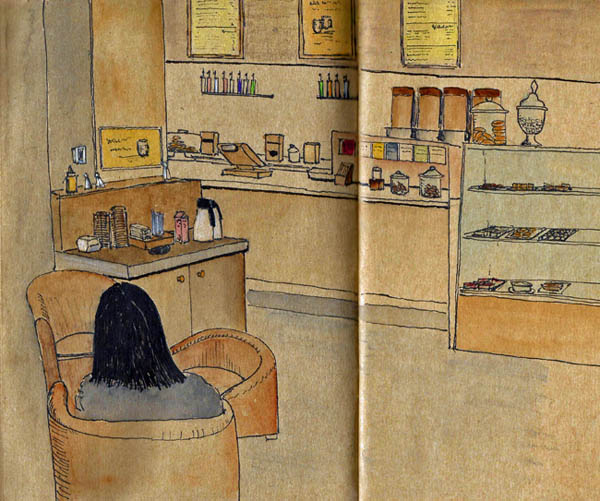 When I finished the ink work I paused to drink some of my coffee. It was still warm. I added the color, took a breath, and drank some more coffee. It wasn’t very warm. I guess I’m going to have to acquire a taste for cold coffee as I’ve certainly acquired a taste for sketching in coffee shops.
When I finished the ink work I paused to drink some of my coffee. It was still warm. I added the color, took a breath, and drank some more coffee. It wasn’t very warm. I guess I’m going to have to acquire a taste for cold coffee as I’ve certainly acquired a taste for sketching in coffee shops.





